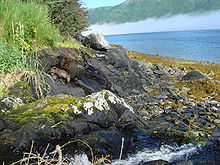Raspberry Island (Alaska)
| Raspberry Island | ||
|---|---|---|
| Waters | Pacific Ocean | |
| Archipelago | Kodiak Archipelago | |
| Geographical location | 58 ° 4 ′ N , 153 ° 11 ′ W | |
|
|
||
| length | 28 km | |
| width | 12 km | |
| surface | 192 km² | |
| Residents | 4th <1 inh / km² |
|
Raspberry Island is an island in the Kodiak Archipelago in Alaska in the United States . It lies between Kodiak Island and Afognak Island . The Kupreanof Strait separates Raspberry Island from Kodiak Island and the Raspberry Strait separates them from Afognak. The island is 192 km² and is home to 4 people (as of 2000). On the island there is the ghost town of Port Wakefield and the Raspberry Island Remote Lodge which offer overnight accommodations in the wilderness. Energy for this is generated by hydropower plants. The city of Kodiak is approximately 1.5 hours by boat or 0.5 hours by flight. The raspberry island takes its name from the many salmonberries (magnificent raspberries) that can be found all over the island.
history
When Russian fur traders took control of the island in the 18th century, they drove away the indigenous people who had always lived there, the Unangan . They almost completely wiped out the local sea otters , but their populations have now recovered well. There were a few fish canning factories on the island in the early 20th century, such as Port Wakefield and Northwest Cannery . These operated for a couple of decades and then abandoned, leaving only one fox fur farm in Northwest Cannery. From 1915 to 1935 there were gold washers on Raspberry Beach , in the northwest of the island.
Flora and fauna


The Sitka spruce is the dominant tree species on Raspberry Island . The spruce forests are repeatedly interrupted by entire fields of salmon berry bushes , alders and wildflowers. Wild blueberries and cranberry bushes grow at higher altitudes . The animal world is also abundant, in addition to Sitka black - tailed deer , red fox and Kodiak bears, there are also yellow-headed lobsters and bald eagles . Afognak and Raspberry Island are the only areas in Alaska where moose live. The Roosevelt elk who live on the island are all descended from eight cows that were relocated from the Olympic Peninsula in 1928 . The elk population on the island has developed splendidly. Some older bulls weigh up to 600 kg . The muskrats were also successfully settled on Raspberry Island . Occasionally whales migrate down the Raspberry Strait, but then have to turn back because the water becomes too shallow. The island is home to many bald eagles.
Individual evidence
- ↑ Raspberry Island: Blocks 2033, Census Tract 1, Kodiak Island Borough, Alaska United States Census Bureau.
- ↑ Afognak quadrangle (PDF; 108 kB) In: Alaska Resource Data File . United States Geological Survey . February 22, 1999. Retrieved October 24, 2007.
- ^ Fred Hirschmann: Alaska from the Air . Graphic Arts Center Publishing , May 1999, ISBN 1-55868-466-2 , p. 24.
- ^ A b Nancy Gates (ed.): The Alaska Almanac: Facts about Alaska 30th Anniversary Edition . Alaska Northwest Books, November 2006, ISBN 0-88240-652-3 .
- ^ Penny Rennick: Mammals of Alaska . Alaska Geographic Society, November 1996, ISBN 1-56661-034-6 .
- ↑ Bob Robb: The Ultimate Guide to Elk Hunting . The Lyons Press, January 2001, ISBN 1-58574-180-9 .

